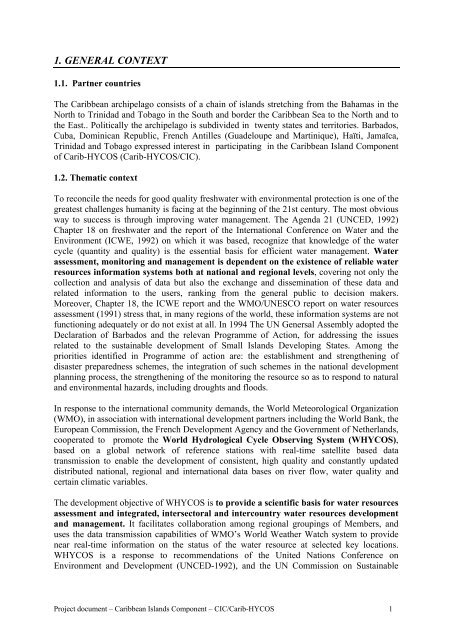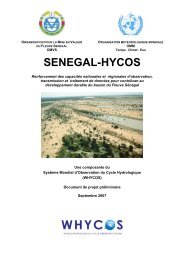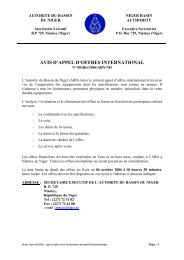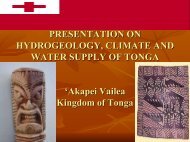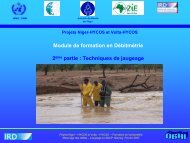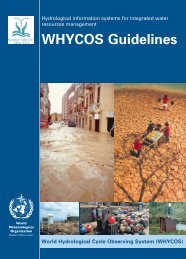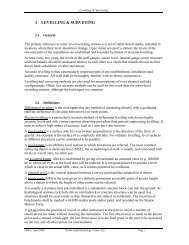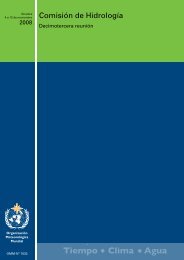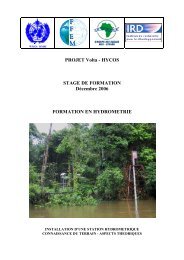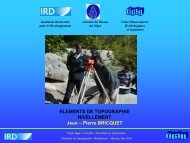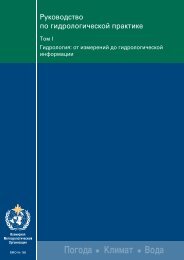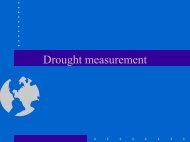CARIB-HYCOS - WHYCOS
CARIB-HYCOS - WHYCOS
CARIB-HYCOS - WHYCOS
Create successful ePaper yourself
Turn your PDF publications into a flip-book with our unique Google optimized e-Paper software.
1. GENERAL CONTEXT1.1. Partner countriesThe Caribbean archipelago consists of a chain of islands stretching from the Bahamas in theNorth to Trinidad and Tobago in the South and border the Caribbean Sea to the North and tothe East.. Politically the archipelago is subdivided in twenty states and territories. Barbados,Cuba, Dominican Republic, French Antilles (Guadeloupe and Martinique), Haïti, Jamaïca,Trinidad and Tobago expressed interest in participating in the Caribbean Island Componentof Carib-<strong>HYCOS</strong> (Carib-<strong>HYCOS</strong>/CIC).1.2. Thematic contextTo reconcile the needs for good quality freshwater with environmental protection is one of thegreatest challenges humanity is facing at the beginning of the 21st century. The most obviousway to success is through improving water management. The Agenda 21 (UNCED, 1992)Chapter 18 on freshwater and the report of the International Conference on Water and theEnvironment (ICWE, 1992) on which it was based, recognize that knowledge of the watercycle (quantity and quality) is the essential basis for efficient water management. Waterassessment, monitoring and management is dependent on the existence of reliable waterresources information systems both at national and regional levels, covering not only thecollection and analysis of data but also the exchange and dissemination of these data andrelated information to the users, ranking from the general public to decision makers.Moreover, Chapter 18, the ICWE report and the WMO/UNESCO report on water resourcesassessment (1991) stress that, in many regions of the world, these information systems are notfunctioning adequately or do not exist at all. In 1994 The UN Genersal Assembly adopted theDeclaration of Barbados and the relevan Programme of Action, for addressing the issuesrelated to the sustainable development of Small Islands Developing States. Among thepriorities identified in Programme of action are: the establishment and strengthening ofdisaster preparedness schemes, the integration of such schemes in the national developmentplanning process, the strengthening of the monitoring the resource so as to respond to naturaland environmental hazards, including droughts and floods.In response to the international community demands, the World Meteorological Organization(WMO), in association with international development partners including the World Bank, theEuropean Commission, the French Development Agency and the Government of Netherlands,cooperated to promote the World Hydrological Cycle Observing System (W<strong>HYCOS</strong>),based on a global network of reference stations with real-time satellite based datatransmission to enable the development of consistent, high quality and constantly updateddistributed national, regional and international data bases on river flow, water quality andcertain climatic variables.The development objective of W<strong>HYCOS</strong> is to provide a scientific basis for water resourcesassessment and integrated, intersectoral and intercountry water resources developmentand management. It facilitates collaboration among regional groupings of Members, anduses the data transmission capabilities of WMO’s World Weather Watch system to providenear real-time information on the status of the water resource at selected key locations.W<strong>HYCOS</strong> is a response to recommendations of the United Nations Conference onEnvironment and Development (UNCED-1992), and the UN Commission on SustainableProject document – Caribbean Islands Component – CIC/Carib-<strong>HYCOS</strong> 1


